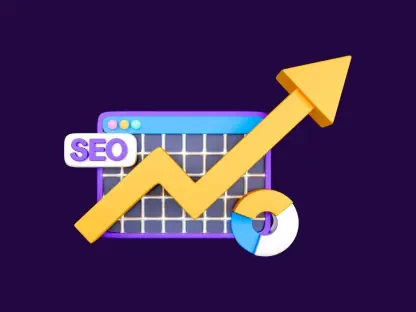The digital transformation within the business landscape has culminated in the emergence of autonomous revenue engines powered by artificial intelligence (AI). These advanced systems are revolutionizing how companies manage conversion rates and customer engagement by facilitating continuous and proactive interactions across multiple touchpoints. This shift signifies a departure from traditional marketing strategies, propelled by the capabilities of AI to drive more effective and streamlined customer experiences.
Traditional Challenges in Marketing Strategies
Conventional strategies like A/B testing, rule-based marketing automation, and structured sales funnels have historically guided businesses in optimizing processes. However, these methods come with significant limitations due to their dependency on manual processes. Managing multiple tools and platforms can encumber marketing teams, leading to inefficiencies and delays in responding to customer behavior. This fragmented system often results in a reactive rather than proactive marketing approach.
Moreover, generic messaging and limited personalization pose major challenges. Traditional strategies rely heavily on broadly-targeted messages, which may capture initial interest but often fail to meet the nuanced demands of today’s informed and diverse customer base. This approach can lead to disengagement and missed opportunities, as businesses struggle to offer interactions that feel personally relevant to each customer.
Limitations of Reactive Approaches
A prevalent issue with traditional marketing strategies is their reactive nature. Companies frequently adjust their tactics only after recognizing a problem, which puts them perpetually behind the curve of customer expectations. This delayed response prevents businesses from capitalizing on emerging trends and real-time shifts in customer behavior, leading to inconsistent and suboptimal outcomes.
Furthermore, this reactive stance significantly affects revenue predictability. Traditional methods do not allow for real-time data analysis and strategy adjustment, resulting in erratic revenue streams and unpredictable outcomes. Without an adaptive system that continuously learns and evolves, businesses find it difficult to allocate resources effectively, making long-term planning and sustainable growth more challenging.
The Advent of Autonomous Revenue Engines
The introduction of autonomous revenue engines marks a paradigm shift from conventional marketing techniques. These AI-driven systems operate around the clock, analyzing customer behavior, optimizing interactions, and fine-tuning engagement strategies—all without human intervention. This automation reduces the inefficiencies inherent in traditional methods and creates a more responsive and streamlined process.
At their core, autonomous revenue engines manage and enhance customer interactions across various channels efficiently. They continuously learn from real-time data to ensure that each touchpoint is as personalized and effective as possible. The integration of these advanced systems can eliminate many of the obstacles that businesses face with fragmented tools and manual adjustments.
Key Transformations in Customer Interactions
Intelligent omni-channel engagement is one of the standout features of autonomous revenue engines. These systems provide seamless, personalized experiences across channels such as email, SMS, and push notifications. By coordinating interactions across multiple platforms, the engines create a coherent narrative that guides the customer through their journey, regardless of the device or medium they engage with.
Another significant transformation is dynamic customer segmentation. Unlike traditional strategies that segment customers based on static demographics, autonomous engines utilize AI to create dynamic, behavior-based segments. These segments adapt in real time as customers interact with the business’s digital touchpoints, allowing for highly targeted messaging and offers. This level of personalization significantly enhances conversion rates by addressing individual customer needs and preferences.
Proactive Conversion and Continuous Engagement
Autonomous revenue engines are designed to be anticipative rather than merely responsive. They monitor behavioral signals closely and trigger well-timed alerts or incentives to nudge customers toward completing a purchase. For instance, if a user lingers on a product page or abandons a shopping cart, the system can instantly deploy a personalized offer, such as a discount or additional information, to encourage the customer to finalize the transaction.
These systems extend their capabilities beyond initial conversion efforts to manage the entire customer lifecycle. They employ automated re-engagement strategies that include follow-up emails and loyalty rewards. Such consistent engagement ensures that customers remain active participants, contributing to a steady and predictable revenue stream over extended periods.
Elevating Personalization and Customer Experience
In an era where personalization is crucial, autonomous revenue engines leverage real-time data to elevate customer engagement strategies to unprecedented levels. Every interaction is tailored to resonate with the individual customer, making them feel understood and valued. This approach helps businesses forge stronger connections with their customers, resulting in increased loyalty and satisfaction.
The capability of these systems to synchronize multi-channel experiences ensures that each touchpoint serves a specific purpose within a larger, well-orchestrated strategy. By delivering messages that reflect a coordinated effort rather than isolated interactions, businesses can nurture customer relationships more effectively. This holistic approach boosts overall customer satisfaction and establishes a more engaging brand presence.
Achieving Predictable and Scalable Revenue
One of the most significant advantages of autonomous revenue engines is their ability to establish a steady and predictable revenue stream. These systems continuously optimize strategies based on real-time data, ensuring that revenue generation remains consistent and scalable. By relentlessly pursuing efficiency and effectiveness, they enable businesses to maintain high performance levels even as they grow.
Scalability and resource efficiency are critical benefits of these advanced systems. As businesses expand, the volume of customer interactions naturally increases. Autonomous engines handle this growth effortlessly without a proportional increase in resources. This ability to scale efficiently allows businesses to focus on strategic initiatives rather than being bogged down by operational challenges.
Addressing Adoption Challenges
While the benefits of autonomous revenue engines are clear, their adoption comes with its own set of challenges. Data privacy and compliance are major concerns, given the vast amounts of customer data these systems analyze. It is crucial for businesses to implement robust security protocols to ensure compliance with data protection regulations and maintain customer trust.
Another challenge is balancing automation with the human touch. There is a concern that overreliance on automation might erode the personal element of customer interactions. However, these systems are designed to complement human efforts by automating routine tasks, allowing human teams to focus on activities that require creativity and empathy. Implementing a gradual transition helps to mitigate these issues, allowing businesses to test the systems on a small scale and build stakeholder confidence before full adoption.
The Future of Revenue Optimization
The transformative potential of autonomous revenue engines is just beginning to be realized. Future advancements in AI promise even greater levels of personalization and predictive analytics. These developments will enable businesses to anticipate customer needs and deliver hyper-personalized experiences, further enhancing customer satisfaction and loyalty.
As businesses look toward the future, investing in next-generation technology and fostering a culture of continuous innovation are essential steps for staying ahead of the competition. Prioritizing the integration of AI-driven systems will not only improve immediate performance but also position companies to capitalize on emerging trends and opportunities in revenue generation.
Pioneering the Path to Success
The digital transformation of the business world has led to the rise of autonomous revenue engines powered by artificial intelligence (AI). These cutting-edge systems are completely changing how companies handle conversion rates and customer engagement. By enabling continuous and proactive interactions across a variety of touchpoints, businesses are moving away from traditional marketing approaches.
AI’s advanced capabilities allow for more efficient and effective customer experiences, as these intelligent systems provide personalized interactions based on real-time data. This evolution signifies a significant shift from standard marketing methods to a more dynamic and responsive approach, driven by AI’s ability to analyze vast amounts of information quickly and accurately.
AI-powered systems help businesses anticipate customer needs, tailor communications, and optimize sales processes, ultimately leading to higher conversion rates and enhanced customer satisfaction. In this new era, companies can develop more meaningful relationships with their customers, foster brand loyalty, and achieve sustained growth.
Overall, the integration of AI within business operations marks a progressive step towards creating smarter, more adaptive revenue management strategies that align with the ever-changing demands of the modern consumer landscape. This technological advancement is not merely a trend but a fundamental transformation of how businesses interact with their customers and drive revenue.









